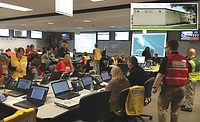California County Emergency Operations Center Improves Situational Awareness

Contra Costa County in California has opened a new Emergency Operations Center (EOC) featuring a state-of-the-art Situation Room equipped with the latest real-time visualization technology. The EOC serves as a command center in the event of a crisis or natural disaster. Its role is to improve emergency response, including the mobilization of municipal, county, and private resources.
Contra Costa County determined that it needed video technology that would help the EOC improve situational awareness and increase efficiency. Contra Costa County selected RGB Spectrum’s Galileo display processor coupled with its Zio AV-over-IP platform for its support of diverse signal sources, ability to disseminate information to local and remote locations simultaneously, and 4K image quality.
Rosendin Electric, an audio-visual design-build integrator based in San Jose, California, was commissioned to design and deploy the Center’s visualization system.
At the core of the Emergency Situation Room is a massive 32’ wide x 14’ high video wall powered by RGB Spectrum’s Galileo video wall processor. The large video wall comprises 48, 55-inch LCD screens in an 8-wide by 6-high array, flanked by four 86-inch auxiliary displays interspersed throughout the room.
The system’s video processing can display an unlimited number of source signals on the main video wall and on ancillary 86-inch displays. The processor consolidates critical visuals and data to provide a centralized, correlated view of the tactical situation. Source signals are displayed in windows of any size, anywhere. Operators can switch and route inputs, choose customizable, preset display layouts, and pan and zoom around items of interest. Operators collaboratively view this information for purposes of assessment, analysis and decision-making.
A critical requirement for Contra Costa County was the ability to share visuals and data both throughout the EOC and with agencies offsite. Critical information is simultaneously displayed on the video wall and shared with remote facilities via IP video streams on local area (LAN) and wide area (WAN) networks, with a VPN for added security. To share visuals with remote locations, the Zio AV-over-IP platform supports both baseband inputs and IP streams at up to 4K 60p resolution, including maps, news feeds, TV broadcasts, interagency communications, Internet data, traffic management systems, surveillance cameras, and the Galileo video wall itself.
The platform enables critical visuals and data to be shared locally and remotely, giving EOC staff and outside agencies access to each other’s resources. All video, audio, and control data are converted to IP packets that are switched and routed to any location on the network via a LAN/VPN. Zio encoders ingest baseband inputs and encode them into H.264 streams which are fed to recipients inside and outside facility.
Rick Kovar, Emergency Services Manager for the Contra Costa County Sheriff’s Office, commented, “It is extremely important for EOC personnel to be able to investigate an incident and make decisions on deploying resources. One of the things we learned from previous disasters is that we need to maximize situational awareness. The video wall is key for achieving this. In a wildfire situation, for example, we have access to fire cameras across the county. We have GIS maps that display hotspots. There’s data available from a variety of sources. RGB Spectrum’s systems allow for their efficient transmission and display to all decision makers. This improves the common operating picture throughout the facility.”
Looking for a reprint of this article?
From high-res PDFs to custom plaques, order your copy today!





